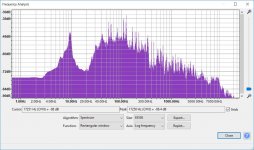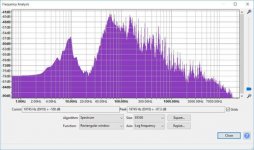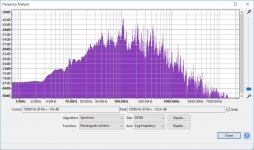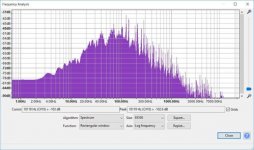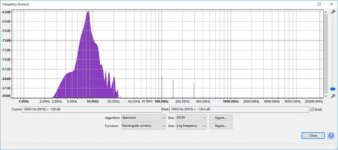My method is to play a silent track and look at the spectrum. If you get a 16Hz peak, that is likely to be the Fres. I've not tried seperating vertical and horizontal from that as these are likely to be different.
But personally I would see 16Hz as livable with. There is little to no music that will stimulate that and it's easily damped with an FD200. But people have had success from 6Hz up so go figure.
thanks guru Bill
I had not heard of that method before
gots lots to learn
My method is to play a silent track and look at the spectrum. If you get a 16Hz peak, that is likely to be the Fres. I've not tried seperating vertical and horizontal from that as these are likely to be different.
But personally I would see 16Hz as livable with. There is little to no music that will stimulate that and it's easily damped with an FD200. But people have had success from 6Hz up so go figure.
Bill, where did you get this method from? I am doing the same, and I thought I invented it 😀. Reached to this method by thinking of the noise signal chain testing method.
I'm a little more conservative than yourself, I put the bar at 10Hz. Which is what I got using my SME Series III (5g effective mass), a Benz Micro Gold cartridge with 15cu compliance (Benz datasheet) and 5.8g mass (weighted) plus 1g of fixture hardware. In excellent agreement with the calculators, which IMO validates both the Benz Micro datasheet and the noise resonance testing method. With other cartridges I did not bother to measure the resonance, it could not be higher than the Benz one.
Bill, where did you get this method from? I am doing the same, and I thought I invented it 😀. Reached to this method by thinking of the noise signal chain testing method.
Could you explain " the noise signal chain testing method ", please ?
thanks in advance
PHONO Cartridge Compliance, Tonearm Mass, System Resonance, Loading of MC and MM Capacitance, RIAA Characteristic
the above would be a good place to start Carl and would be the whys before it starts getting complicated ( I started this thread to learn more too)
Ahh. Ok. Looks like I’m ok at 16 Hz. I will try the sound card trick when I get around to it.
The system sounds good to my ears in any event 🙂
I am no guru, just another interested party trying to learn things.thanks guru Bill
I got the idea from LD, so I'll let you decide who thought of it first and then we can name it accordingly.Bill, where did you get this method from? I am doing the same, and I thought I invented it 😀. Reached to this method by thinking of the noise signal chain testing method.
The SME 30H arm set it as 12Hz and the B&K papers suggest that, provided you have some damping higher is better. I know you don't like the silicon trough so I won't argue with 10.I'm a little more conservative than yourself, I put the bar at 10Hz. Which is what I got using my SME Series III .
I ended up selling the series III to a friend in Norway. He did do a load of tests for me of LF plots on both silent tracks and with music which I haven't had time to analyse fully but will pop a few up here if of interest. He also tried the same with damping fluid in place for comparison. He's housebound at the moment after an operation so has more time for these things.
🙂 reckon you deserve that Bill, you've helped a lot of peeps.I got the idea from LD, so I'll let you decide who thought of it first and then we can name it accordingly.
And just about all I have in common with guru is going silent for long periods... more like a heretic moi, some might say! I do still reckon there's untapped potential in vinyl playback...
LD
I ended up selling the series III to a friend in Norway. He did do a load of tests for me of LF plots on both silent tracks and with music which I haven't had time to analyse fully but will pop a few up here if of interest. He also tried the same with damping fluid in place for comparison. He's housebound at the moment after an operation so has more time for these things.
I for one am interested
Could you explain " the noise signal chain testing method ", please?
A general method for measuring and probing systems:
Spectrum Analysis of Noise | Spectral Audio Signal Processing
that also works well for audio:
Audio Testing With Noise | audioXpress
thank you for the URL's syn08
I have much to learn before applying them
Question to all:
Has the AES published any papers on tonearm/cartridge/compliance compatibility ?
I have much to learn before applying them
Question to all:
Has the AES published any papers on tonearm/cartridge/compliance compatibility ?
Cheaper than test records and with the right articles quicker knowledge than figuring it out myself
(although you can't just blindly accept any paper as truth)
thank you all for the pointers so far
keep them coming
Couldn't find the ones I was looking for yet, but here is a starter for 10 on the effect of a silicone damping trough on an SME 3009 S111 with a MM cart on it. These were actually playing music so hitting the same point on the same track each time for analysis is nigh on impossible and audacity is a slighly blunt tool for this sort of analysis. However gives you an idea.
On first eyeball you seem to lose as much as you gain, so 10Hz and below the resonance is damped, but 20-50Hz looks worse. I have not sat an pondered this so just throwing it out there. I am sure I can get the raw files for anyone who has an idea how to analyse.
On first eyeball you seem to lose as much as you gain, so 10Hz and below the resonance is damped, but 20-50Hz looks worse. I have not sat an pondered this so just throwing it out there. I am sure I can get the raw files for anyone who has an idea how to analyse.
Attachments
Welcome back LD! Hi Bill!
I've typically considered somewhere in the range of 10 - 12Hz as good enough, and am a lazy hack compared to Bill or Lucky.
The last time I looked at this was when developing the EQ for my Panasonic strain gauge cartridge project - in that set up it appeared that the LF arm/cart resonance was close to 20Hz which made equalizing the problematic LF response of the strain gauge difficult. (Or maybe more correctly the problematic everywhere else response of the strain gauge) I did sort it out enough eventually...
Tracking behavior on warped records is sometimes a good indication of a resonance frequency that is too low - you can sometimes actually see the arm oscillate for a few cycles. (True only if gross mis-tracking isn't the end result 😛 )
Some cartridge manufacturers specify one or both compliances, sometimes don't specify which they've specified and also have not standardized on frequency for the specification. I have not figured out how to meaningfully compare compliance measured at 10Hz vs 100Hz.
I've typically considered somewhere in the range of 10 - 12Hz as good enough, and am a lazy hack compared to Bill or Lucky.
The last time I looked at this was when developing the EQ for my Panasonic strain gauge cartridge project - in that set up it appeared that the LF arm/cart resonance was close to 20Hz which made equalizing the problematic LF response of the strain gauge difficult. (Or maybe more correctly the problematic everywhere else response of the strain gauge) I did sort it out enough eventually...
Tracking behavior on warped records is sometimes a good indication of a resonance frequency that is too low - you can sometimes actually see the arm oscillate for a few cycles. (True only if gross mis-tracking isn't the end result 😛 )
Some cartridge manufacturers specify one or both compliances, sometimes don't specify which they've specified and also have not standardized on frequency for the specification. I have not figured out how to meaningfully compare compliance measured at 10Hz vs 100Hz.
Seems like a pink noise track would give you much better repeatability. I'm not really able to deduce anything about the damping trough vs undamped from these captures.
Some are a bit too small and I can't see them.
It does make me want to focus more on digital and tape which is pretty much what I am doing these days.
Some are a bit too small and I can't see them.
It does make me want to focus more on digital and tape which is pretty much what I am doing these days.
And an example of a silent track.
Bill, when you say silent track, is that just the inner (lead off) track or are you using a test record?
Does arm resonance vary with the position of the stylus on the record ie outer tracks vs inner tracks?
Seems like a pink noise track would give you much better repeatability. I'm not really able to deduce anything about the damping trough vs undamped from these captures.
.
My bad. I should have attached larger pictures. But I should note these were mainly to get a feeling for what happens to inform what measurements would be useful and how to analyse them.
That is silence between tracks. Just to show the resonance can always be seen.
Thanks Bill
I know how to measure it nowhere
- Home
- Source & Line
- Analogue Source
- Tonearm/Cartridge/Compliance: Compatability
